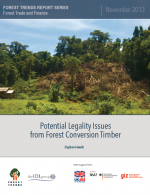Potential Legality Issues from Forest Conversion Timber
By Daphne Hewitt View PublicationThis paper investigates whether there is evidence that timber generated during the conversion of natural forest areas to non-forest or plantation use in tropical and sub-tropical timber-producing countries could be a significant source of illegal
timber entering markets. It asks two related questions: How important a timber source is forest conversion? And what are the sources of potential illegality associated with timber from forest clearance?
Much attention in the past decade has focused on efforts to control deforestation through the elimination of illegal logging practices in the production of timber from designated forest areas; however, it is not certain that illegal logging itself is the most significant driver of the observed rate of deforestation. The conversion to other land uses, particularly commodity agriculture, appears to be more significant. Increasing regulatory control, and cost, on managed forest sources risks altering market dynamics and driving timber supply through alternate channels, such as conversion, by making agricultural clearance
permits a more attractive option for accessing timber. Therefore it is important to understand the volumes of timber entering markets from conversion and the possible associated sources of illegality to ensure that these markets are as
appropriately regulated as other channels.
This paper looks at the potential for timber from forest conversion to be classed as illegal. It then moves on to discuss the type of information needed to start to frame policies and initiatives that address incidences of illegality and irregularity in forest conversion worldwide and to ensure that control of illegal timber harvesting includes measures to prevent illegal
conversion from undermining such initiatives.

